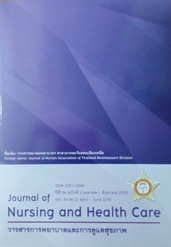ความสัมพันธ์ระหว่างอาการปวดศีรษะ อาการอ่อนล้า และความแปรปรวน ของการนอนหลับกับความสามารถในการปฏิบัติกิจกรรมของ ผู้ป่วยบาดเจ็บที่ศีรษะระดับเล็กน้อย Relationships between Headache, Fatigue, Sleep Disturbance, and Performance in Mild Head Injury Patients
คำสำคัญ:
อาการปวดศีรษะ อาการอ่อนล้า ความแปรปรวนของการนอนหลับ ความสามารถในการปฏิบัติกิจกรรม ผู้ป่วยบาดเจ็บที่ศีรษะระดับเล็กน้อย headache, fatigue, sleep disturbance, performance, mild head injury patientsบทคัดย่อ
การวิจัยเชิงพรรณนานี้ มีวัตถุประสงค์เพื่อ 1) ศึกษาการเกิดอาการปวดศีรษะ อาการอ่อนล้า และความ
แปรปรวนของการนอนหลับของผู้ป่วยบาดเจ็บที่ศีรษะระดับเล็กน้อยภายหลังบาดเจ็บ 24 ชั่วโมง 1 สัปดาห์ และ 2
สัปดาห์ 2) ศึกษาความสัมพันธ์ระหว่างอาการดังกล่าวและความสามารถในการปฏิบัติกิจกรรมของผู้ป่วยบาดเจ็บ
ที่ศีรษะระดับเล็กนอ้ ยภายหลังไดรั้บบาดเจ็บ 2 สัปดาห ์ สุม่ ตัวอยา่ งดว้ ยวิธีกำหนดชว่ งเวลาศึกษาและคัดเลือกกลุม่
ตัวอย่างตามคุณสมบัติที่กำหนดจากผู้ป่วยบาดเจ็บที่ศีรษะระดับเล็กน้อยที่เข้ารับการรักษา ณ หอผู้ป่วยศัลยกรรม
อุบัติเหตุโรงพยาบาลชลบุรี ในช่วงเดือนมีนาคม ถึงเดือนกันยายน พ.ศ. 2558 จำนวน 90 ราย เครื่องมือที่ใช้ในการ
วิจัยประกอบด้วย แบบสอบถามข้อมูลส่วนบุคคล แบบสอบถามอาการปวดศีรษะ แบบสอบถามอาการอ่อนล้า
แบบสอบถามความแปรปรวนของการนอนหลับ และแบบสัมภาษณ์ความสามารถในการปฏิบัติกิจกรรม วิเคราะห์
ข้อมูลด้วยสถิติพรรณนา และสถิติสหสัมพันธ์ของสเปียร์แมนผลการวิจัยพบว่า ภายหลังได้รับบาดเจ็บที่ศีรษะใน 24 ชั่วโมงแรก สัปดาห์ที่ 1 และสัปดาห์ที่ 2 กลุ่มตัวอย่างมีอาการปวดศีรษะร้อยละ 97.8; 96.7 และ 85.5 ตามลำดับ มีอาการอ่อนล้าร้อยละ 96.7; 94.4 และ 88.9 ตามลำดับและมีความแปรปรวนของการนอนหลับร้อยละ 100 ทั้ง 3 ระยะของการศึกษาติดตาม กลุ่มตัวอย่างสามารถปฏิบัติกิจกรรมได้เหมือนเดิมภายหลังได้รับบาดเจ็บ แต่รู้สึกว่าปฏิบัติได้ยากขึ้นเมื่อเปรียบเทียบกับก่อนได้รับบาดเจ็บทั้งในสัปดาห์ที่ 1 และ 2 (M =3.70, SD = .27 และ M =3.79, SD = .28 ตามลำดับ) และภายหลังได้รับบาดเจ็บที่ศีรษะ 2สัปดาห์ พบว่า อาการปวดศีรษะ อาการอ่อนล้า และความแปรปรวนของการนอนหลับมีความสัมพันธ์ทางลบระดับปานกลางกับความสามารถในการปฏิบัติกิจกรรมอย่างมีนัยสำคัญทางสถิติ (rs = -.48, -.56 และ -.51, p < .01 ตามลำดับ)การวิจัยครั้งนี้เสนอแนะว่า พยาบาลและบุคลากรทีมสุขภาพควรประเมินอาการปวดศีรษะ อาการอ่อนล้า และความแปรปรวนของการนอนหลับและพัฒนาแนวทางการดูแลเพื่อลดความรุนแรงของอาการดังกล่าวที่มีผลต่อความสามารถในการปฏิบัติกิจกรรมของผู้ป่วยบาดเจ็บที่ศีรษะระดับเล็กน้อยตั้งแต่ระยะแรกภายหลังได้รับบาดเจ็บที่ศีรษะ
This descriptive research aimed to 1) explore the occurrence of symptoms including headache,fatigue, and sleep disturbance at 24 hours, one week, and two weeks after head injury and 2) examine relationships between headache, fatigue, sleep disturbance, and performance in mild head injury patients,after 2 weeks of head injury. 90 patients with mild head injury were recruited by the inclusion criteria at Trauma ward of Chonburi Hospital during March to September, 2015. Research instruments included the Personal Information questionnaire, the Brief Pain Inventory (BPI) questionnaire, the Barrow Neurological
Institute (BNI) questionnaire, the Fatigue Scale, the Verran and Synder-Halpern Sleep Scale, and the Rivermead Head Injury Follow Up questionnaire (RHFUQ). Data were analyzed by using descriptive statistics, and Spearman’s rank correlation coefficients.
The results showed that at 24 hours, the 1st week, and the 2nd week after head injury, samples reported having headache for 97.8%; 96.7%, and 85.5% respectively, while the occurrence of fatigue were 96.7%; 94.4%, and 88.9% respectively. Interestingly, 100% of samples reported that they had sleep disturbance all the time after head injury. Samples also reported that there was no change in their performance but it was more difficult in ability to perform activities of daily living by the 1st week and the 2nd week after the injury (M = 3.70, SD = .27; M = 3.79, SD = .28, respectively). In addition, there ere statistically negative relationships between headache, fatigue, sleep disturbance, and performance at the 2nd week after the injury (rs = -.48, -.56 and -.51, p< .01 respectively).
The findings reflects that to promote performance in mild head injury patients after the injury,nurses and health care providers should realize the important of symptom occurrences including headache,fatigue, and sleep disturbance after the injury. Symptoms assessment should be continuously performed in order to early manage those symptoms and enhance performance among this population.



